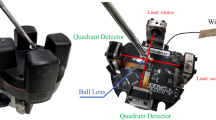Abstract
One major effect that can deteriorate the geometric accuracy of a calibrated machine tool is the elastic deformation of its structure due to heat transferred into it. Different solutions to this problem have been presented in the past—e.g. temperature-controlled structural parts and environments—but they are complex and expensive. In an on-going Collaborative Research Centre funded by the German Research Foundation scientists are working on model-based compensation and correction strategies. In this paper, a different approach is discussed using point diffraction interferometry to directly measure the three-dimensional distance between tool centre point and workpiece coordinate system. Commercially available three-dimensional measurement systems are introduced representing the state of the art before explaining the basics of point diffraction interferometry. Different parameters are investigated using simulation tools and the achievable accuracy of the approach is evaluated. Additionally, some suggestions are made concerning hardware requirements of a planned demonstrator.














Similar content being viewed by others
References
Kinkel S, Lay G (2006) Technologietrends in der Produktion: Praxis der Anlagenmodernisierung in der deutschen Metall- und Elektroindustrie. Mitteilungen aus der Produktionsinnovationserhebung 39, Fraunhofer Institut für System—und Innovationsforschung (ISI), Karlsruhe
Schwenke H, Knapp W, Haitjema H, Weckenmann A, Schmitt R, Delbressine F (2008) Geometric error measurement and compensation of machines—an update. CIRP Ann 57(2):660–675. doi:10.1016/j.cirp.2008.09.008
Bryan J (1990) International status of thermal error research. CIRP Ann 39(2):645–656. doi:10.1016/S0007-8506(07)63001-7
Weck M, Brecher C (2006) Werkzeugmaschinen 5—messtechnische untersuchung und beurteilung, dynamische stabilität. Springer, Heidelberg
Brecher C, Hirsch P (2004) Compensation of thermo-elastic machine tool deformation based on control internal data. CIRP Ann 53(1):299–304. doi:10.1016/S0007-8506(07)60702-1
Großmann K (2012) Thermo-energetische gestaltung von werkzeugmaschinen. ZWF 107(5):307–314
Großmann K (2012) Energieeffizient zerspanen. Maschine + Werkzeug 113(4):78–79
Hedges T, Takagi H, Pratt T, Sobel MJ (2001) Position measurement system and method using cone math calibration. Patent, US6535282B2
Wang Z, Mastrogiacomo L, Franceschini F, Maropoulos P (2011) Experimental comparison of dynamic tracking performance of iGPS and laser tracker
Müller T, Schwendemann J (2012) iGPS—ein vielseitiges Messsystem hoher Genauigkeit. avn 119(4):146–157
Muelaner JE, Wang Z, Martin O, Jamshidi J, Maropoulos P (2010) Verification of the indoor GPS system, by comparison with calibrated coordinates and by angular reference. J Intell Manuf (Online First: 12/06/2010)
Depenthal C, Schwendemann J (2009) iGPS—a new system for static and kinematic measurements. In: Grün A, Kahmen H (ed) Optical 3-D Measurement techniques IX, Vienna
Schmitt R, Nisch S, Schönberg A, Demeester F, Renders S (2010) Performance evaluation of iGPS for industrial applications. In: Mautz R, Ingensand H, Kunz M (ed) Proceedings of the 2010 international conference on indoor positioning and indoor navigation, Zurich, IEEE, New York
Spath D (2002) ACCOMAT—die genauigkeitsgeregelte Maschine. Abschlussbericht zum BMBF-Leitprojekt ACCOMAT (1998–2002). Final report, University of Karlsruhe
Weule H, Plutowsky A, Höller F, Spieweck M, Werner J (2001) A three-degree-of-freedom measurement system for machine tools. Prod Eng Res Devel 8(2):95–98
Schmalzried S (2007) Dreidimensionales optisches messsystem für eine effizientere geometrische Maschinenbeurteilung. Dissertation, University of Karlsruhe, Shaker, Aachen
Plutowsky A (2002) Charakterisierung eines optischen messsystems unter den bedingungen des Arbeitsraums einer werkzeugmaschine. Dissertation, University of Karlsruhe
Steel WH (1983) Interferometry. University Press, Cambridge
Bruning JH (1978) Fringe Scanning Interferometers. In: Malacara D (ed) Optical shop testing. Wiley, New York, pp 409–437
Ghiglia DC, Pritt MD (1998) Two-dimensional phase unwrapping. Wiley, New York
Kim S-W, Yang DY (2001) New design of precision CMM based upon volumetric phase-measuring interferometry. CIRP Ann 50(1):357–360. doi:10.1016/S0007-8506(07)62139-8
Rhee H-G, Kim S-W (2002) Absolute distance measurement by two-point-diffraction interferometry. Appl Opt 41:5921–5928. doi:10.1364/AO.41.005921
Rhee H-G, Chu J, Lee Y-W (2007) Absolute three-dimensional coordinate measurement by the two-point diffraction interferometry. Opt Express 15(8):4435–4444. doi:10.1364/OE.15.004435
Fletcher R (1987) Practical methods of optimization. Wiley, New York
Young M (2000) Optics and lasers: including fibers and optical wave guides. Springer, Berlin
Brecher C, Klein W, Linder F (2011) Verfahren und System zur Korrektur der Position eines durch eine Steuerung bewegten Objektes. Pending patent, DE102011011286A1
DIN ISO 10791 (2001) Machine tools—test conditions for machining centres. DIN German institute for standardization (ed)
Edlén B (1966) The refractive index of air. Metrologia 2:71–80
Birch KP, Downs MJ (1994) Correction of the updated Edlén equation for the refractive index of air. Metrologia 31:315–316
Lide DR (ed) (2003) CRC handbook of chemistry and physics. A ready-reference book of chemical and physical data. Tayler & Francis, Boca Raton, FL
Acknowledgments
The authors would like to thank the European Commission for funding this work as part of Project Chameleon within the 7th Framework Programme of the European Union.
Author information
Authors and Affiliations
Corresponding author
Rights and permissions
About this article
Cite this article
Brecher, C., Krella, C. & Lindner, F. Simulative investigation of point diffraction interferometry with regard to machine tool calibration. Prod. Eng. Res. Devel. 7, 309–318 (2013). https://doi.org/10.1007/s11740-012-0432-4
Received:
Accepted:
Published:
Issue Date:
DOI: https://doi.org/10.1007/s11740-012-0432-4




